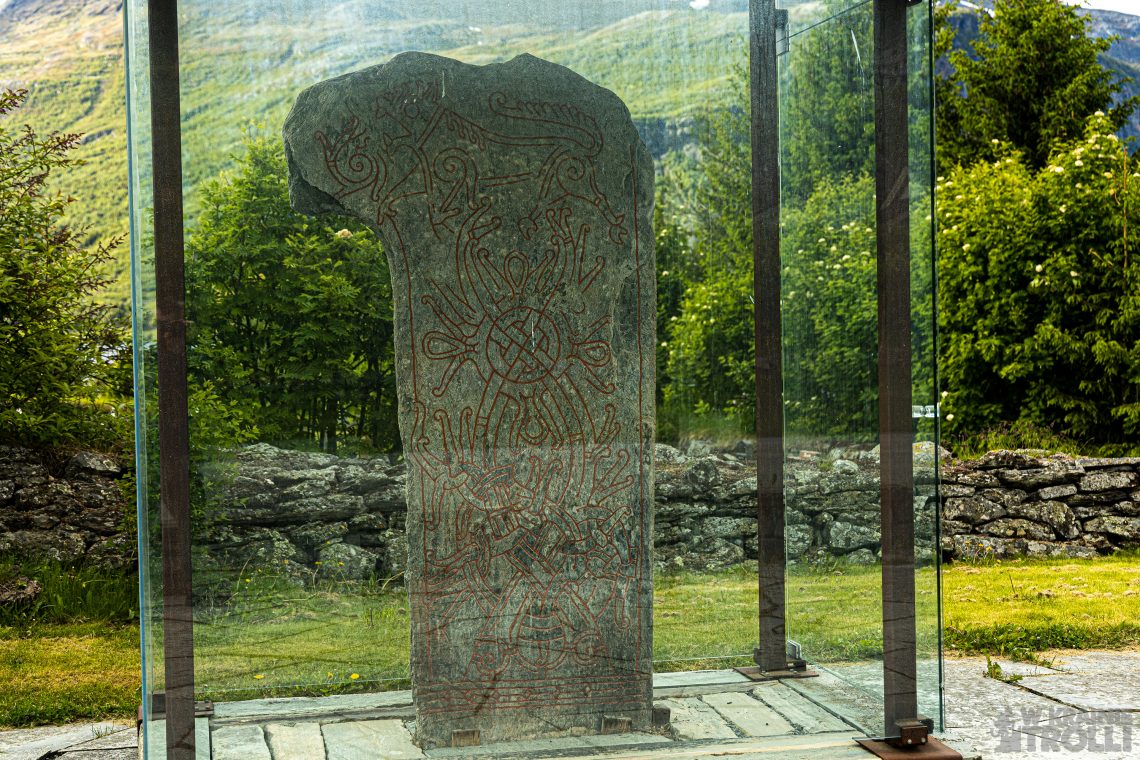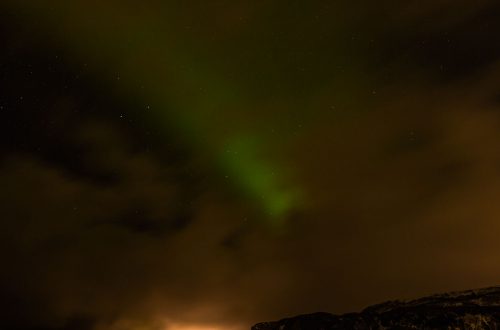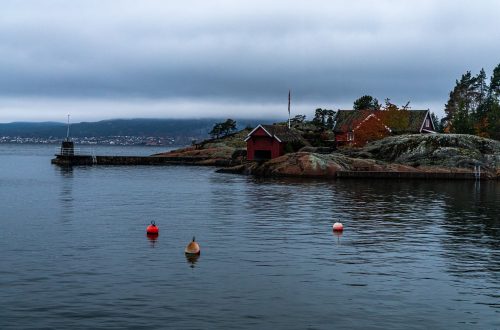
Vangsteinen
Poza górami jest jeszcze jeden powód, żeby odwiedzić Vang. I nie jest to drewniany kościółek, bo ten został stąd przeniesiony w XIX w. i wszyscy wiemy dokąd trafił. Obecnie w Vang znajduje się murowana świątynia, podobna do wielu innych w niewielkich miejscowościach w całej Norwegii. Najbliższy drewniany kościółek można za to znaleźć w sąsiednim Øye, o czym była mowa tutaj. Ów powód, dla którego warto zatrzymać się choć na chwilę w Vang to kamień. I oczywiście nie jest to byle jaki kamień ale płyta runiczna, pochodząca z ery wikingów. Oto jak się prezentuje.
Obecnie wystawiona przed kościołem, ukryta za szkłem stanowi główną atrakcję miasteczka. Pierwotnie Kamień Vang znajdował się przed kościołem klepkowym (tym, który obecnie można podziwiać w Karpaczu), ale po jego rozbiórce i powstaniu nowej świątyni (lata 40-te XIX wieku), przeniesiono go w obecne miejsce. Ma nieregularny kształt i wymiary 2,15 m wysokości, 1,25 m szerokości i 8-13 cm grubości. Na kamieniu obok napisów runicznych rzuca się w oczy bogata ornamentyka zwierzęca.
Zakłada się, że łupkowy kamień postawiono w latach 1010 – 1040, a styl zdobień nawiązuje do stylu Ringerike. Podobne żłobienia w kamieniu odnalezione zostały w Ål w Hallingdal. Kamień z Vang (Vangsteinen) jest porównywany do podobnych obiektów w Jelling w Danii, z uwagi na podobieństwo zdobień.
Obraz przedstawia serpentynowe linie i liście układające się w krzyż, a może stylizowane drzewo. U góry stylizowany stwór przypominający lwa. Niektóre szczegóły uległy całkowitej erozji, a znaczna część szkicu jest teraz tylko niejasna do prześledzenia. Brakujące szczegóły zostały tu zrekonstruowane w oparciu o ogólną charakterystykę stylu Ringerike. Wśród brakujących elementów najbardziej widoczny jest czubek pyska bestii i przednie łapy, a także szczegóły splotu wąsów dwóch łodyg wystających ukośnie z każdej strony górnego płata krzyża z rozety.
Na bocznej krawędzi kamienia wyryto runiczny napis:
ᚴᚭᛍᛆ ᛬ ᛍᚢᚿᛁᚱ ᛬ ᚱᛁᛍᛐᚢ ᛬ ᛍ(ᛐ)ᛁᚿ ᛬ ᚦᛁᚿᛍᛁ ᛬ ᛆᚠ(ᛐ)ᛁᚱ ᛬ ᚴᚢᚿᛆᚱ ᛬ ᛒᚱᚢᚦᚢᚱ ᛬ ᛍᚢᚿ
Transliteracja:
kosa : sunir : ristu : s(t)in : þinsi : af(t)ir : kunar : bruþur:sun
W Staronordyjskim:
Gása synir reistu stein þenna eptir Gunnar, bróðurson.
Co przetłumaczyć można:
Synowie Gasiego wznieśli ten kamień ku pamięci Gunnarra, (ich) siostrzeńca.
Besides the mountains, there is one more reason to visit Vang. And it is not a wooden church, because it was moved from here in the 19th century and we all know where it ended up. Currently, there is a stone temple in Vang, similar to many others in many small towns across the Norway. The nearest wooden church can be found in neighboring Øye, as I wrote here. The reason why you should stay in Vang for a while is the Stone. And of course it is not just any stone but a runic plate from the Viking era.
Currently, displayed in front of the church, hidden behind glass, is the main attraction of the town. Originally, the Vang Stone was located in front of the stave church (the one that can now be admired in Karpacz, Poland), but after its demolition and the erected of a new temple (1840s), it was moved to its present location. It has an irregular shape and measures 2.15 m in height, 1.25 m in width and 8-13 cm in thickness. On the stone, next to the runic inscriptions, the rich animal ornamentation catches the eye.
It is assumed that the slate stone was erected in the years 1010 – 1040, and the style of decorations refers to the Ringerike style. Similar grooves in the stone have been found at Ål in Hallingdal. The stone from Vang (Vangsteinen) is compared to similar objects in Jelling, Denmark, due to the similarity of the decorations.
The painting shows serpentine lines and leaves arranged in a cross, or maybe a stylized tree. At the top, a stylized creature resembling a lion. Some details have been completely eroded and much of the sketch is now only vague to be traced. Missing details here have been reconstructed based on the overall Ringerike style characteristics. Among the missing pieces, the tip of the beast’s mouth and front paws are the most visible, as well as the details of the whiskers weave of the two stalks protruding diagonally from each side of the upper lobe of the cross from the rosette.
A runic inscription was carved on the side edge of the stone:
ᚴᚭᛍᛆ ᛬ ᛍᚢᚿᛁᚱ ᛬ ᚱᛁᛍᛐᚢ ᛬ ᛍ (ᛐ) ᛁᚿ ᛬ ᚦᛁᚿᛍᛁ ᛬ ᛆᚠ (ᛐ) ᛁᚱ ᛬ ᚴᚢᚿᛆᚱ ᛬ ᛒᚱᚢᚦᚢᚱ ᛬ ᛍᚢᚿ
Transliteration:
kosa: sunir: ristu: s (t) in: þinsi: af (t) ir: kunar: bruþur: sun
In Old Norse:
Gása synir reistu stein þenna eptir Gunnar, bróðurson.
What can be translated to English:
Gasi’s sons erected this stone in memory of Gunnarr, (their) nephew.









